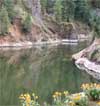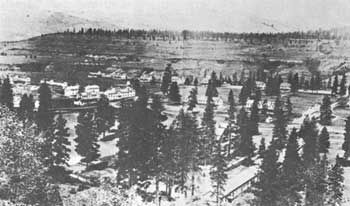





Survey of Historic Sites and Buildings
 |
LAKE ROOSEVELT NATIONAL RECREATION AREA fomerly Coulee Dam National Recreation Area Washington |
 |
| ||
The 660 miles of shoreline along Franklin D. Roosevelt Lake not only provide extensive recreational facilities and a scenic wonder land, but also have considerable historical significance. Thirteen Indian tribes, seminomadic hunters and fishers of Salishan stock speaking the same language, originally inhabited the northeastern part of present Washington. The first Europeans to penetrate the region were fur trappers of the Canada-based North West Co., which between 1807 and 1821 monopolized fur trapping and the Indian trade in the Columbia Basin. In 1821 the North West Co. merged with the Hudson's Bay Co., which maintained the monopoly into the 1840's and 1850's—even after 1846, when Britain recognized U.S. sovereignty over the area. In 1855-56 a minor gold rush to the Colville River caused the Indians to begin a series of retaliations, and U.S. settlers did not move into the Columbia Basin until 1858, after the Army brought the Indians under control.
In 1872 the U. S. Government created the Colville Indian Reservation and concentrated there several thousand members of 10 tribes inhabiting northeastern Washington—joined in 1885 by some of the nontreaty Nez Perces returning to the Pacific Northwest from Indian Territory, where they had been confined after their defeat in 1877. In 1881 the Army set up the Spokane Reservation, directly to the east of the southern part of the Colville Reservation.
 |
| Fort Spokane during its active years. (National Archives) |
The year before, though the reservation Indians were peaceful, to quiet settlers' fears of further hostilities, Gen. Oliver O. Howard had activated Fort Spokane, on the south bank of the Spokane River about a mile above its junction with the Columbia. Inactivated in 1899, its history was rather uneventful. It served as an Indian school until 1914 and an Indian hospital until 1929.
The National Park Service administers Lake Roosevelt National Recreation Area in cooperation with the Bureaus of Reclamation and Indian Affairs. The three buildings that are extant from Fort Spokane—the brick guardhouse, brick magazine, and large frame stables—have been restored. Ruins of the brick granary have been stabilized, and the foundations and sites of other buildings, all of which were frame, have been marked. The visitor center, in the guardhouse, interprets the history of the fort and region.
 |
 |
http://www.cr.nps.gov/history/online_books/soldier-brave/sitea25.htm
Last Updated: 19-Aug-2005